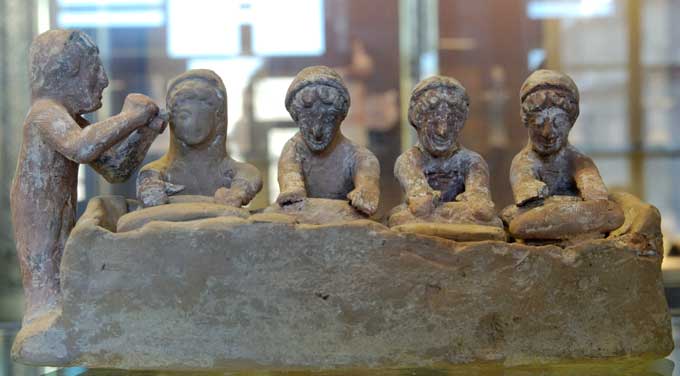Kratinos the Athenian Born: 519 BC Died: 422 BC
Kratinos was one of the most important comedy writers of Ancient Greece.
He was a contemporary of Aeschylos and Aristophanes.He wrote 24 stories which were characterised by their very sharp scathing humour.
Participation in competitions:
425 BC Cheimazomenoi 2nd prize Aharneis ( by Aristophanes) joint 2nd 424 BC Satyrs 2nd prize Ippeis (by Aristophanes) 1st
423 BC Pytine 1st prize Nefele ( by Aristophanes) last
Diousalexandros, another of his plays, was found in a papyrus in 1903.
The following are plays by Kratinos.
Kratinos was awarded nine times for his plays. His numerous work fragments were saved by Ancient biologist Atheneos.
His scathing humour was impetuous and prominent. He is said to have been initiated in Orphism and was a follower of Bacchus.
Kratinos belonged to the Oeneis tribe, one of the ten tribes of Ancient Athens.
He is referred to by proponents of the Erasmian theory of Ancient Greek pronunciation. For this, his famous phrase is: «Ὁ δ' ἠλίθιος ὥσπερ πρόβατον βῆ βῆ λέγων βαδίζει».
There are, however, serious objections to the Erasmian style of Greek pronunciation by many scholars.
For more information on Kratinos look up Wikipaedia.
TRIBES OF ANCIENT ATHENS
1. Erehtheis2. Aigeis
3. Pandionis
4. Leondis
5. Akamandis
6. Oeneis
7. Kekropis
8. Ippothondis
9. Aeandis
10. Andiohis
MUNICIPALITIS OF THE OENEIS TRIBE (Organised by Kleisthenis 6th c. B.C.
1. Aharnai2. Voutadai
3. Epikifisia
4 Thria
5. Ippotamathai
6. Kothokithai
7. Lakiathai
8. Lousia
9. Meliti
10. Oi
11. Perithoithai
12. Ptelaia
13. Tyrmithai
14. Fyli















